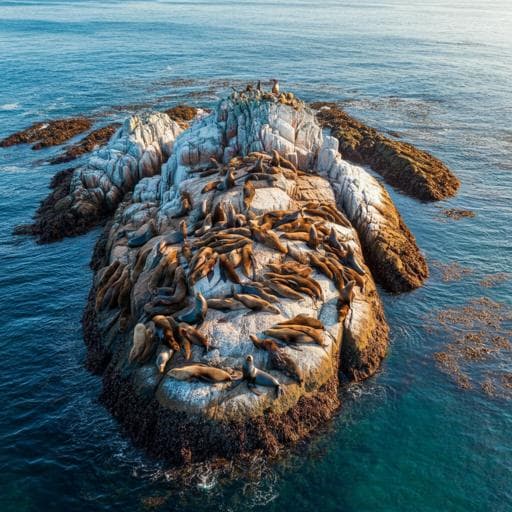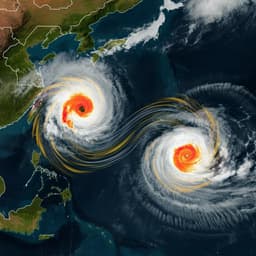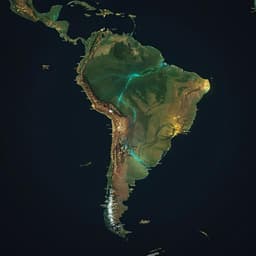
Biology
The northernmost haulout site of South American sea lions and fur seals in the western South Atlantic
N. Procksch, M. F. Grandi, et al.
Discover the fascinating seasonal and spatial dynamics of pinnipeds at the Wildlife Refuge of Ilha dos Lobos in Brazil! This study, conducted by a team of experts including Natália Procksch and M. Florencia Grandi, reveals a peak of 304 sea lions and emphasizes the importance of this site. Join us in exploring how managing human actions can protect these incredible marine mammals.
~3 min • Beginner • English
Introduction
Southern Brazil hosts seasonal occurrences of South American fur seals (Arctocephalus australis) and South American sea lions (Otaria flavescens), with occasional Antarctic/subantarctic pinnipeds. Brazil has no breeding colonies and only two marine protected haulout sites: the Wildlife Refuge of Molhe Leste (WRML) and the Wildlife Refuge of Ilha dos Lobos (WRIL). Dispersal to Brazil typically occurs post-breeding (austral autumn–spring), likely aided by the Malvinas Current. Population statuses of these species vary regionally: South American sea lions are globally Least Concern but show contrasting trends (declines in Uruguay and Falklands/Malvinas, increases in Argentina), and South American fur seals are also Least Concern with substantial populations in the Falklands/Malvinas and Uruguay/Argentina. Prior studies at WRIL did not use aerial photography. Understanding seasonal abundance and spatial distribution within the WRIL is vital for management, given its status as the current northern distribution limit and exposure to human activities. This study aims to provide new seasonal abundance and first spatial distribution data for pinnipeds at WRIL, testing hypotheses that: (1) abundance differs by month within the July–November window; (2) males predominate; and (3) species show spatial preferences on the island.
Literature Review
Background literature indicates: (a) seasonal northward dispersal of South American otariids post-breeding, driven by oceanographic conditions such as the Malvinas Current; (b) contrasting population trends for South American sea lions across the Atlantic sector and large global estimates for both species; (c) threats including habitat degradation and fisheries interactions, particularly for sea lions; (d) the paucity of information on non-breeding dispersal periods; and (e) methodological considerations favoring aerial photographic censuses to reduce counting errors compared to land-based observations. Previous WRIL studies (1990s–early 2000s) conducted land/vessel counts and identified peak occupation in winter–spring but lacked spatially explicit analyses. The WRIL’s importance as a non-breeding haulout near the northern range limit underscores the need for integrated abundance and spatial analyses to inform MPA management.
Methodology
Study area: WRIL is a coastal island 1.8 km off Torres, Rio Grande do Sul, Brazil, with ~16,966 m² exposed at low tide and a 500 m buffer around the island. Aerial photographic surveys: 20 flights (helicopter or UAV) were conducted July–November across 2010–2018, coinciding with regional right whale surveys. Distribution of flights: July (5), August (3), September (6), November (6); none in October or December. Helicopter surveys used a Canon EOS 7D with 100–400 mm lens, altitudes 100–250 m; September 2018 used a DJI Mavic Pro I UAV at similar altitude. Only images with suitable environmental conditions were analyzed. Permits: SISBIO 69627 and 35606-1; institutional ethics PPECEUA05.2019. Image analysis: One best image per flight was selected; counts performed using Otariidae 1.0 software. Individuals were identified to species, age, and where possible sex by morphology from images. Sea lions were classified into adult males, subadult males, juveniles, yearlings, and potential adult females (females classified as ‘potential’ due to rarity and identification uncertainty at non-breeding sites). Fur seals were classified by age (yearlings, juveniles, subadults) and adult males; sex for non-adults was undetermined. Temporal analysis: For each species, a Negative Binomial GLMM (lme4) modeled counts with month as fixed effect (July, August [intercept], September, November) and year as random effect; Likelihood ratio tests compared full vs. intercept-only models. Spatial analysis: All 20 images were georeferenced in ArcGIS 10.6.1 using ESRI basemaps and identifiable ground control points. The island was divided into three equal-area sectors (North, Center, South). A 5×5 m grid was overlaid. Each individual was digitized as a point. Kernel Density Estimation (KDE) incorporated group size to produce density surfaces by month and year, enabling assessment of clustering, spatial preferences, and occupied area across sectors.
Key Findings
- Peak abundance: Maximum count of 304 pinnipeds in September 2018 (all three species present), and 225 in November 2018.
- Monthly means (all species): September mean 143.67 (SD ±34.16); July mean 96 (±22.22); November mean 74.67 (±30.95); August mean 67.67 (±12.88).
- Temporal effects: GLMMs indicated no significant month effect (July–November period) on abundance for sea lions (χ²=5.77, df=3, p=0.12) or fur seals (χ²=5.32, df=3, p=0.15). Among-year SD estimates: 0.18 (sea lions), 1.32 (fur seals).
- Species composition: South American sea lion (O. flavescens) was most frequent and abundant, with a peak of 139 in July 2012. Age/sex totals across surveys: subadult males n=1343 (88.24%); adult males n=91 (5.98%); potential females n=33 (2.17%); juveniles n=42 (2.76%); yearlings n=13 (0.85%). Potential females recorded in 10/20 surveys; yearlings present in three surveys (July 2011; September and November 2012).
- South American fur seal (A. australis): total n=468 overall, generally fewer than sea lions except in September (n=199) and November 2018 (n=102) when fur seal yearlings predominated. Age structure: yearlings n=382 (81.62%); juveniles n=41 (8.76%); subadults n=41 (8.76%); adult males n=4 (0.86%); adult males recorded in four surveys (July/Sep 2011; Sep 2012; July 2018).
- Southern elephant seal (M. leonina): three subadult males recorded (July 2012; September 2013; September 2018).
- Spatial distribution: Of 1,993 plotted positions, 1,912 (95.94%) were in the North sector, 81 (4.06%) in the Center, and none in the South. By species: sea lions 1,522 total (99.15% North; 0.85% Center); fur seals 468 total (85.47% North; 14.53% Center); elephant seals 3 total (100% North).
- KDE showed persistent clustering in the northern portion across months/years. Densities were generally higher in spring than winter, with spatial expansion into the Center only in September and November 2018. No behavioral response to aircraft was observed at 100–250 m altitude.
Discussion
Findings partially supported the hypotheses: (1) Contrary to expectations, no significant monthly differences in abundance were detected within July–November, although September often showed higher counts. (2) Strong male bias was confirmed: sea lions were dominated by subadult and adult males; fur seals were largely yearlings with few adult males. Occasional potential female sea lions suggest some non-breeding or pup-loss females disperse to WRIL. (3) Clear spatial preferences were detected: both species predominantly used the northern sector, forming dense clusters (thigmotaxis), likely due to higher, drier, and more protected terrain offering shelter from waves and tides. The seasonal presence aligns with post-breeding dispersal aided by the Malvinas Current. Sea lion numbers were relatively stable over time, possibly reflecting local foraging opportunities and interactions with fisheries near an important harbor. Fur seals were typically less abundant, with a notable surge of yearlings in late 2018 that may reflect interannual variability or broader population dynamics; corroborating beach surveys also reported unusually high fur seal numbers then. The spatially explicit results provide actionable guidance for zoning and activity planning within the MPA.
Conclusion
This study provides the first spatially explicit assessment of pinniped use of WRIL and updated seasonal abundance patterns using aerial photographic censuses over nine years. WRIL is confirmed as an important northern haulout site for South American sea lions and fur seals, with occupation strongly concentrated in the island’s north. Management should prioritize scheduling land-based research and recreational activities during summer months when pinnipeds are largely absent and foster regulated, education-oriented marine mammal tourism during winter–spring, when haulouts and right whales co-occur. Continued long-term monitoring, including months outside July–November and areas further north, is recommended to detect trends, understand anomalies such as the 2018 fur seal peak, and inform adaptive management under changing environmental and anthropogenic pressures.
Limitations
Surveys were limited to July–November, with no flights in October or December, and only 20 survey flights across nine years, potentially missing variability outside this window. Species, age, and sex classifications were based on aerial imagery and external morphology, with females identified as ‘potential’ due to identification uncertainty at non-breeding sites. Analyses were confined to a single haulout (WRIL), and counts depended on suitable weather/sea conditions on survey days.
Related Publications
Explore these studies to deepen your understanding of the subject.







